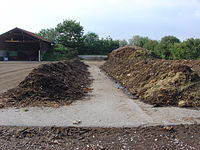
Photo from wikipedia
Laboratory testing of sediments frequently involves manipulation by amendment with contaminants and homogenization, which changes the physicochemical structure of sediments. These changes can influence the bioavailability of divalent metals, and… Click to show full abstract
Laboratory testing of sediments frequently involves manipulation by amendment with contaminants and homogenization, which changes the physicochemical structure of sediments. These changes can influence the bioavailability of divalent metals, and field and mesocosm experiments have shown that laboratory‐derived thresholds are often overly conservative. We assessed the mechanisms that lead to divergence between laboratory‐ and field‐derived thresholds; specifically, we assessed the importance of slow equilibration to solid‐phase ligands and vertical stratification. To mimic natural physicochemical conditions, we uniquely aged sediment with a flow‐through exposure system. These sediments were then homogenized and compared, toxicologically, with freshly metal‐amended sediments in a 28‐d chronic toxicity bioassay with the amphipod Hyalella azteca. We assessed concentration–response relationships for 3 metals (copper, nickel, and zinc) and 5 geochemically distinct sediments. We observed minimal differences in growth and survival of H. azteca between aged and freshly spiked sediments across all sediments and metals. These trends suggest that a loss of toxicity observed during long‐term sediment aging is reversed after sediment homogenization. By comparison with mesocosm experiments, we demonstrate that homogenizing sediment immediately before toxicity assays may produce artificially high toxicity thresholds. We suggest that toxicity assays with sediments that maintain vertical redox gradients are needed to generate field‐relevant sediment metal toxicity thresholds. Environ Toxicol Chem 2019;38:1995–2007. © 2019 SETAC.
Journal Title: Environmental Toxicology and Chemistry
Year Published: 2019
Link to full text (if available)
Share on Social Media: Sign Up to like & get
recommendations!